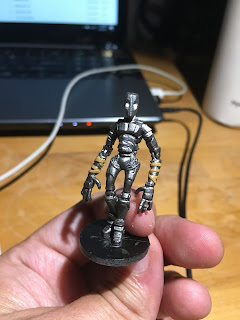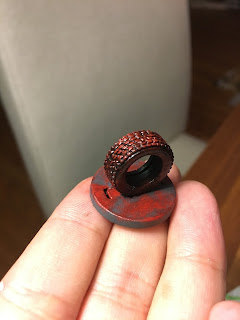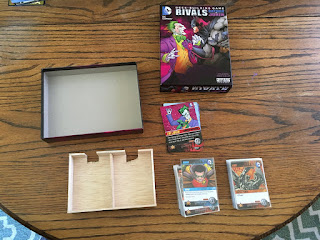Hi everyone (all 9 of you who checked out my last post but will probably never check back to see this...)!
Saturday night is my current gaming group's regular night to play. That will likely be changing soon since I am moving to a different state, but, alas, that is a story for another time. Last night we had a group of five, and played five games: Abyss, Sushi Go Party!, Roll for the Galaxy, Bang! The Dice Game, and Ghost Stories. I'm going to give a short review and play synopsis of each game.
Let's start at the beginning. When the first four of us arrived, we decided to play something quick and fun while we waited for our fifth. A personal favorite of mine, and a game that we haven't played for quite some time, is Abyss. I'm not the best at describing what kind of game this is (but I suppose I should work on that if I'm going to continue to write this gaming blog). The most accurate way I can describe it is as a layered purchasing game with an incredible underwater theme. Essentially the game plays buy purchasing small cards using pearls as currency. These small cards are color coded and have different values which allow the player to purchase larger cards. The larger cards have special abilities, and award the player the points needed to win the game. Maybe not the best description, but let me say that it is easy to pick up, incredibly fun, relatively short, and has some absolutely astounding artwork. Like I said, it is one of my favorites, and I would highly recommend it to any gamer, casual or serious.
Our game of Abyss was really great! I started off with an early lead, choosing to recruit mostly farmer lords for their high point value. I didn't get a lot of special abilities or keys (another purchasing layer I forgot to mention earlier), but my strategy did seem to get into the head of at least one of my opponents. Another player, new to the game, tried a strategy I'd never thought of before. She collected several of the small cards with large purchase value, and then made several purchases at the end of the game all at once--kind of a come out from behind approach. It didn't work out for her this game, but I do wonder if it could work if she tried it again after a little more experience with the game. In the end, one of my opponents ended up beating me, but only by a few points. He had the advantage of having two very good key tiles. A close and exciting game!
Near the end of Abyss our fifth player showed up. We talked a bit about what game we would like to play next, but I was persistent and really wanted to play one that I'd just purchased a couple of days earlier: Sushi Go Party! I had also just made a custom DIY box organizer for it that I wanted to show off. All of us except for our fifth player had played the original Sushi Go, so it was very smooth sailing getting that going. Sushi Go! is a very simple drafting (pick and pass) game. Each player has a hand of cards with various types of sushi worth varying points. Some cards only work in combos, so they can be risky, but they are worth more points than the cards that can be played alone. Sushi Go! is incredibly quick, easy to play, and highly addictive. The cards even sport absolutely adorable cartoon sushi characters!
The newest version, Sushi Go Party! isn't an expansion, but I wish that it were. Instead, Gamewright decided to release a new version of the game that contained everything that the original had, but then add to it. That's great for new players, but annoying for those of us who already owned the original game. The new additions to the game are awesome though, and I can't say that I in anyway regret my purchasing it. Instead of one deck of cards that is used for every game, Party allows players to mix and match a variety of different rolls, appitizers, specials, and deserts for each game they play. This adds a little bit of time to the set up and tear down of the game, so if you're looking for something to play on the go or at a restaurant, brewery, etc., I would suggest the orginal game. If you are a fan of the original and are looking for some more variety, or if the idea of an ever-so-slightly-more complex game seems more appealing, Sushi Go Party! is for you. A couple of other advantages to party are the cool game board for tracking points, the fact that it can be played by 8 people (as compared to 6) so it's great for a large group, and the super adorable soy sauce (or maybe sake) bottle movers!
Our game of Sushi Go Party! was fairly uneventful. We chose to play one of the suggested decks for players who wanted to see what was new for the Party version. We were a little disappointed during set up because it only contained a few new cards (I think we would have almost preferred all new cards), but we still had a lot of fun with it. Our late arrival ended up destroying the rest of us in points.
At that point, I would have liked to play another round of Sushi Go Party! but I was outvoted. That's ok though, because our next game was another favorite of mine: Roll for the Galaxy. This is another game that I feel unable to describe in too much detail, so I will try to keep it simple. Roll for the Galaxy is a dice building game (like a deck building game, but with a cup of dice). If you've ever played Quarriors, the idea is similar in principal, but Roll is far more complicated, requiring way more strategy, and, in my opinion, about a million times better. Oh, and it's space themed which I love.
Sometimes it's hard to pick a strategy for roll for the galaxy. You have to work both with what your dice are giving you, and what tiles you have. I found my strategy, and I think it was solid, but it was a little too late in the game. I was able to easily color match goods and ships to earn a lot of point through consuming products from my worlds. If I would have committed to this early enough, I think I could have kept a solid lead over my opponents and win early. Unfortunately, one of my opponents had a similar strategy, was able to get more points per shipped product, committed slightly earlier, and had some great tile combos. Our scores didn't end up being very close, but I maintain that I had a solid, winning strategy and that I could have won. Oh well. Again, I was interested in another game of Roll, but my opponent who won Abyss was distressed and refused to play again. He often falls victim to not building a strategy quick enough, and has unfortunately cultivated a self-defeating attitude about Roll.
Next, we tried Bang! The Dice Game. Only two of the five of us had played before, so it was a learning experience for most of us. Bang! is incredibly silly and involves rolling dice Yahtzee style, pressing your luck, and trying to determine the secret identities of the other players. The Western theme, although maybe borderline racist, is very fun, and we spent most of our three games laughing.
I'm not sure yet if I can give a solid review, thumbs up or thumbs down if you will, of Bang! The Dice Game. Although I had a lot of fun playing, it seemed to be very luck based, which is not really my style of game. Furthermore, on the third game, I was the sheriff. The sheriff's job is to seek out and kill the outlaws, usually easily identified because they are shooting the sheriff (the only known identity in the game). That plan goes kaput though when my deputy (whose identity is secret, but goal is in alignment) chooses to shoot me the first round of the game. She said she was trying to through off the scent so that the others wouldn't know she was the deputy. Well, it worked. I spent the entirety of the game trying to eliminate her. This is my biggest issue with secret identity games, and why I can't stand Avalon. My success in the game is dependent on the actions that other's take. One misstep, and suddenly everything is thrown out of whack. That may be appealing to some, but for me it's only frustrating. I will absolutely play another game though, and determine for certain how I feel, one way or the other.
After Bang! our fifth player who arrived late decided that he needed to leave early. With four players left, we decided to finish out the night with a great cooperative game, Ghost Stories. Another super fun game with great artwork, Ghost Stories may be one of the most difficult cooperative games out there. I like to describe it as medieval Chinese ghost busters. Essentially, each player controls a Taoist with a special ability, and together they fight ghosts and incarnations of the Wu Feng (devil). There are cards and dice and tokens and miniatures--everything a gamer loves. The game play is relatively straightforward. Experienced gamers pick it up very quickly, and newcomers learn it within a few rounds.
Like I said though, the game is very difficult. Players are able to "set" the difficulty level by deciding how many incarnations of the Wu Fang to fight and how many life points, or Qi, each player starts with. We chose 3 incarnations (normal mode) and 4 Qi (easy mode). We didn't even make it passed the first incarnation. Oh well. Still a great game that I would play many more times over.
All-in-all, it was a great night, and I look forward to the next!


































